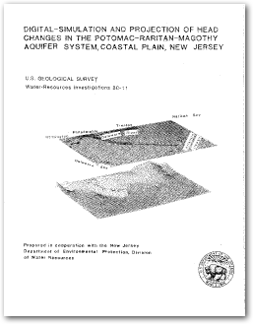Water-Resources Investigations Report 80–11

AbstractThe Potomac-Raritan-Magothy aquifer system of Cretaceous age, which is the principal source of water to the major population and industrial centers in the Coastal Plain of New Jersey, has undergone continuous and widespread reduction in head. The reduced head, already below sea level throughout most of the aquifer system, in conjunction with encroachment of salty water toward centers of pumping, threatens the continued use of the aquifer as a source of freshwater in the area. A single layer, two-dimensional finite difference digital model was used to simulate the response of the aquifer system to pumping stresses during the 18-year period, 1956-73. Model simulations were based on close agreement between (1) observed and calculated heads and head trends for 10 observation wells during the period, 1956-73; and (2) the computed nonpumping steady-state potentiometric surface and a potentiometric surface based on early water-level observations (1900±) solutions. In addition, the hydrologic budget estimated by the model appears to be reasonable for the transient (1956-73) and the steady-state (1900±) solutions. The model was used to compute projected potentiometric heads and trends to the year 2000. Three sets of conditions, all using the 1973 distribution of pumping centers, were simulated. The conditions are:
Under the first set of conditions, further head reduction would cease over very large regions within two years. Under the second set of conditions involving a 3 percent growth rate similar to that experienced during the simulation period, the broad cone of depression already encompassing most of the New Jersey Coastal Plain would broaden and deepen. Heads would range from 60 to 160 feet below National Geodetic Vertical Datum of 1929. The reduction of head after 1973 would approach 90 feet in some areas. The resultant steeper hydraullic gradients would accelerate the rate of movement of salty ground water toward the pumping centers. A freshwater head barrier could be established in the transition zone to prevent migration of salty ground water across a 35-mile stretch in Gloucester, Camden, and Burlington Counties. A line of injection wells would be required, with total rates of injection to the head barrier ranging from about 56 cubic feet per second in 1984 to about 95 cubic feet per second in 2000. Barrier recharge rates would be equivalent to about 20 percent of the ground water pumped in the fine-grid area in any particular year for a 3 percent increase in extractions. |
For additional information contact: Part or all of this report is presented in Portable Document Format (PDF); the latest version of Adobe Reader or similar software is required to view it. Download the latest version of Adobe Reader, free of charge. |
Luzier, J.E., 1980, Digital-simulation and projection of head changes in the Potomac-Raritan-Magothy aquifer system, coastal plain, New Jersey: U.S. Geological Survey Water-Resources Investigations Report 80–11, 72 p., available only at https://pubs.usgs.gov/wri/1980/0011.
Abstract
Introduction
The Potomac-Raritan-Magothy aquifer system
Digital model
Parameter adjustment and acceptance of the model
Model application in water management
Ground-water velocities near fresh to salty water transition zone
Model-estimated ground-water budgets
Suggestions for further study
Summary and conclusions
References